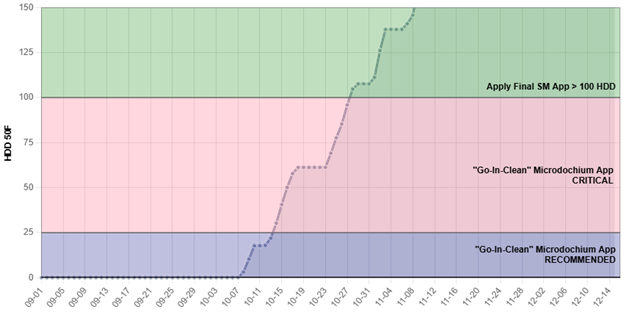Snow Mould: A Persistent Turf Challenge
Snow mould season is upon us and it’s almost time to make one of your most important applications of the year. Snow mould diseases remain a significant concern for turf managers, creating discoloured patches that damage leaves, stems, and crowns. Annual bluegrass and creeping bentgrass are particularly vulnerable, and infestations of pink or grey snow mould can leave putting greens, tees, and fairways unsightly and unplayable when spring arrives.
Snow mould develops under snow cover in cool conditions (0–10 °C), with pathogen sclerotia beginning to germinate in the fall once air temperatures drop to 10–18 °C. Both snow mould and Microdochium patch are caused by the same fungus, Monographella nivale (formerly Microdochium nivale). The distinction lies in conditions: Microdochium patch does not require snow cover, while snow mould develops beneath it.
Strong turf health is a cornerstone of prevention. Cultural practices such as aeration to reduce compaction and thatch, carefully managed nitrogen applications in the fall, and regular additions of plant nutrients like beneficial microbes, humics, and kelp, will strengthen your turf’s natural defenses. In spring, rapid snow removal and clearing of drainage obstructions (such as collar dams) are essential for recovery. Newly seeded turf in the fall requires special care, as young, tender plants—especially when heavily fertilized—are far more susceptible to snow mould pressure entering winter.
Fungicide Timing and Strategy
Even with strong cultural practices, fungicides remain essential for consistent snow mould protection. Research from the University of Wisconsin demonstrates that the optimal timing of a final application is within two weeks of anticipated snowfall just after top growth ceases. Applications made too early can lose effectiveness by 40% or more as products degrade before snow arrives. Similarly, significant rainfall between the final application and snow cover may require an additional treatment to maintain strong protection and ensure healthy turf in spring.
New for 2025: Signature™ XTRA Stressgard® now labelled for Microdochium patch control60g 7-day, 120-180g 14-21 day, and 200g 21-day rates. The only phosphonate in Canada labelled for CONTROL of Microdochium patch, Pythium Root Rot and Blight, and Anthracnose foliar and basal rot. |
Going-in Clean Primer app:
In medium to high pressure areas, it is recommended to go into winter clean – this means using a “Going-in clean” primer application 3-4 weeks before your final snow mould app. Knocking down fall inoculum drastically reduces disease pressure going into winter, making this strategy your optimal defense against the snow mould pathogen. Use Envu’s Turfview™ app to determine your best Go-in clean window. Turfview uses multiple weather stations, allowing for a location specific weather app for your specific microclimate, helping you determine the optimal Go-in clean timing.
TURFVIEW: Snow Mould Application Timing – HDD10C

New for 2025, Signature XTRA Stressgard is now labelled for Microdochium patch control, and is a perfect going-in clean app. Research found that just two apps of Signature XTRA Stressgard at 120g 14-days apart, controlled snow mould by 90-98% in low to medium pressure. In high pressure, we recommend using this powerful tool going-in clean on a 14-21 day schedule prior to your final snow mould app for optimal spring results.
After your targetted primer apps, follow-up with your final snow mould fungicide application prior to the first snowfall. Typically, in low pressure, a single, well-timed application will keep turf sufficiently protected from snow mould.
See our Envu’s snow mould resource page for more information on this strategy and the new Signature XTRA Stressgard Microdochium label expansion.
Final Snow mould app:
Dedicate Stressgard contains the leading DMI chemistry of tebuconazole premixed with the QoI fungicide trifloxystrobin. This combination is blended with Stressgard Technology to deliver consistent and reliable results for snow mould control.
In high-pressure situations on high-quality turf such as putting greens, tank-mixing Dedicate Stressgard with fludioxonil has proven to be a winning combination to knock out snow mould. Studies also show that Fame SC + Mirage Stressgard is a powerful combination as a final snow mould app. Add fludioxonil in very high pressure to your choice of final apps to reduce chances of breakthrough. For spring success, consider adding Signature XTRA Stressgard in a tank-mix with your preferred final app for both Microdochium control and plant health benefits for a top performing snow mould solution.
For rates and more information, download the snow mould solution sheet or contact your local Territory Sales Manager for snow mould control strategies specific to your needs.
